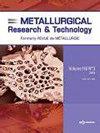Development of thin-gauge low iron loss non-oriented silicon steel
IF 1.1
4区 材料科学
Q3 METALLURGY & METALLURGICAL ENGINEERING
引用次数: 1
Abstract
Microstructure, texture, inclusions and precipitates in Fe-2.97wt%Si non-oriented silicon steel during manufacture were investigated using Scanning Electron Microscopy (SEM), Organic Solvent Electrolysis and Electron Backscattered Diffraction(EBSD)techniques. The P10/400 , P15/50 and B50 of thin-gauge non-oriented silicon steel with 0.3 mm in thickness were 13.85 W/kg, 2.38 W/kg and 1.66 T, respectively. Due to annealing of hot rolled band, the size of precipitates increased. The precipitates are mostly located at the grain boundaries in the annealed sheet, the main and average size of the grain-boundary precipitates were in the range of 30 ∼ 500 nm and 63.2 nm, respectively. The pinning force caused by 100 ∼ 300 nm particles at the grain boundaries was the largest, 70 ∼ 100 nm was second. During annealing of hot rolled band, the α*-fiber texture significantly developed and γ -fiber dropped dramatically. The γ-fiber texture and α*-fiber texture composed the main textures of annealed sheet. The texture randomization would give rise to better magnetic properties compared to the γ -fiber.薄型低铁损无取向硅钢的研制
采用扫描电子显微镜(SEM)、有机溶剂电解和电子背散射衍射(EBSD)技术研究了Fe-2.97wt%Si无取向硅钢在加工过程中的显微组织、织构、夹杂物和析出物。厚度为0.3 mm的薄型无取向硅钢的P10/400、P15/50和B50分别为13.85 W/kg、2.38 W/kg和1.66 T。热轧带材退火后,析出相尺寸增大。在退火薄片中,析出相主要分布在晶界,晶界析出相的主要尺寸在30 ~ 500 nm,平均尺寸在63.2 nm。在晶界处,100 ~ 300 nm颗粒产生的钉住力最大,70 ~ 100 nm颗粒次之。退火过程中,α*纤维织构明显发育,γ纤维织构明显下降。退火板的主要织构为γ纤维织构和α*纤维织构。与γ纤维相比,纹理随机化将产生更好的磁性能。
本文章由计算机程序翻译,如有差异,请以英文原文为准。
求助全文
约1分钟内获得全文
求助全文
来源期刊

Metallurgical Research & Technology
METALLURGY & METALLURGICAL ENGINEERING-
CiteScore
1.70
自引率
9.10%
发文量
65
审稿时长
4.4 months
期刊介绍:
Metallurgical Research and Technology (MRT) is a peer-reviewed bi-monthly journal publishing original high-quality research papers in areas ranging from process metallurgy to metal product properties and applications of ferrous and non-ferrous metals and alloys, including light-metals. It covers also the materials involved in the metal processing as ores, refractories and slags.
The journal is listed in the citation index Web of Science and has an Impact Factor.
It is highly concerned by the technological innovation as a support of the metallurgical industry at a time when it has to tackle severe challenges like energy, raw materials, sustainability, environment... Strengthening and enhancing the dialogue between science and industry is at the heart of the scope of MRT. This is why it welcomes manuscripts focusing on industrial practice, as well as basic metallurgical knowledge or review articles.
 求助内容:
求助内容: 应助结果提醒方式:
应助结果提醒方式:


